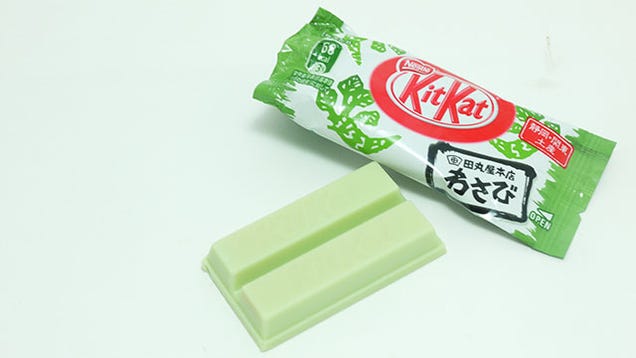WEEK THREE: KON'NICHIWA IN KYOTO

hawkins410
Posts: 2,105 Member
YOU AMAZING RACERS WORKED SUPER HARD THIS WEEK!
IT WAS AN AWESOME BATTLE!
SO IT IS TIME FOR A LITTLE ZEN. JAPANESE STYLE ZEN.
WE ARE HEADED FOR KYOTO, JAPAN!
DISTANCE = 5400 MILES
IT WAS AN AWESOME BATTLE!
SO IT IS TIME FOR A LITTLE ZEN. JAPANESE STYLE ZEN.
WE ARE HEADED FOR KYOTO, JAPAN!
DISTANCE = 5400 MILES
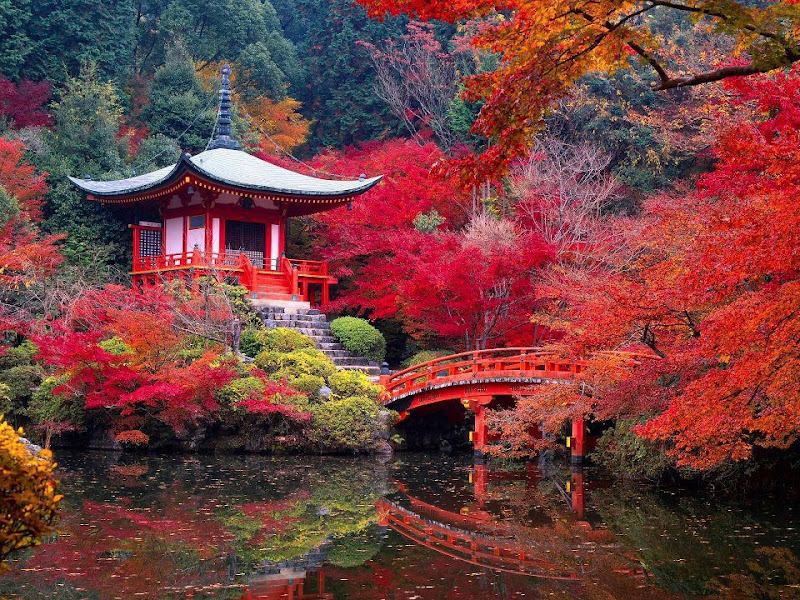
The following YouTube is rather long, but no amount of pictures I post could help you better experience the beauty of Kyoto in the Fall.
Award yourself 15 exercise minutes if you stay active (I recommend a nice stretch) while watching it.
Award yourself 15 exercise minutes if you stay active (I recommend a nice stretch) while watching it.
If you are in too big of a hurry for a little “zen like” experience, there is also a shorter version worth five exercise minutes:
Yes, if you watch them both, you may award yourself 20 minutes. This is a one time only deal! I’m feeling generous. 

Rated one of the Fourteen Favorite Fall Destinations by National Geographic,
KYOTO IS ABSOLUTELY STUNNING IN AUTUMN!
KYOTO IS ABSOLUTELY STUNNING IN AUTUMN!
We are getting there just at the right time! Due to Kyoto’s climate, the leaves are just now starting to turn their brilliant colors of vermillion, crimson, carmine (just to name a few), all set against the stunning greens of cedars, bamboo, and moss gardens that have been so carefully planted to highlight the varying shades of reds and browns.

Known as the “Historical City”, Kyoto was the Imperial Capital of Japan for over 1000 years, making it one of the oldest cities in Asia.
With over 2,000 temples and shrines, Kyoto is worth a visit at any time of the year. The cherry blossoms are fabulous in the Spring, but there are less tourists now and the turning of the leaves is a planned sight that is hard to believe!


Secrets of autumn colors:
1) Fall colors can be enjoyed throughout Japan. However, this seasonal spectacle is said to be particularly beautiful in Kyoto. Shrines and temples such as Tofuku-ji and Kodai-ji, as well as the Arashiyama area seen from tramcars, are the popular spots for viewing autumn colors.
2) Located in the Kyoto Basin, Kyoto has a typical inland climate with sizable changes in temperature throughout the day. This climate and humidity from the city’s many rivers contribute to Kyoto’s exceptional fall color display. During autumn, the leaves turn colors quickly due to sunny days with ample moisture and chilly nights.
3) Reflecting Kyoto’s picturesque aesthetics, trees are often cultivated for their changing foliage colors. For example, deciduous trees are planted among cedars or in moss gardens, so the red and yellow colors stand out more dramatically against the green.
4) For over 1,000 years, Kyoto has continued to celebrate its tradition of appreciating autumn colors. Just as with its treasured architecture, its prized autumn scenery has been carefully shaped by sophisticated techniques. And, its beauty has been painstakingly preserved for hundreds of years through the meticulous maintenance of countless caretakers.


The ground gets redder than the red carpet at the Oscars!

The shrines, temples and gardens are fabulous in the day, but on November 3rd, the nighttime lighting starts!

WOW!
NOVEMBER 3rd is also Cultural Day, a National Holiday. We will be there for some dancing! 

In the Gion District, you can still see women dressed in their kimonos walking the narrow pathways, or riding in rickshaws.

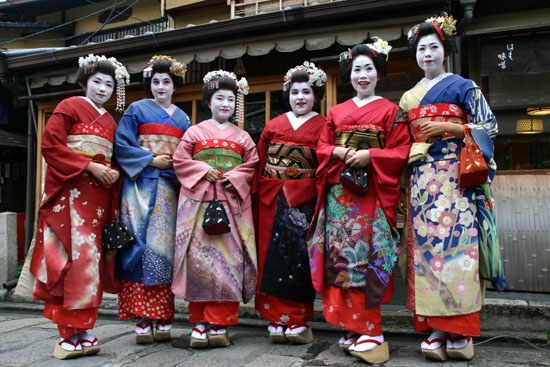


The kimonos are handmade, which often take three years to make, and sometimes are not worn than once!
BUT WE MUST VISIT THE TEMPLES AND SHRINES!
THE GOLDEN PAVILION:

Fushimi Inari Shrine, with it’s amazing 10,000 scared gates:
Each one is donated and carved with the name of a business in hopes of prosperity.

A stroll through the Bamboo Forest is a must. It is rated one of the most romantic places in the world! Awww!

OF COURSE WE MUST SAMPLE SOME LOCAL FOOD!
I could show you some really icky pictures of local “delicacies”, but I rather stick with one of my favorites
THE UNIQUE FLAVORS OF ICE CREAM
KNOWN AS SOFT CREME IN JAPAN!
I could show you some really icky pictures of local “delicacies”, but I rather stick with one of my favorites
THE UNIQUE FLAVORS OF ICE CREAM
KNOWN AS SOFT CREME IN JAPAN!


Although vanilla is probably favored, other flavors include: Green Tea, Wasabi, Sesame Seed, Cherry Blossom, Buckwheat, Cheese (CHEESE?), Purple Sweet Potato, and my personal favorite, Black Squid Ink! 
WE HOPE YOU HAVE FUN IN KYOTO!
REMEMBER TO SAY KON'NICHIWA (HELLO) TO THE LOCALS,
BOW POLITELY
AND ENJOY!
WE HOPE YOU HAVE FUN IN KYOTO!
REMEMBER TO SAY KON'NICHIWA (HELLO) TO THE LOCALS,
BOW POLITELY
AND ENJOY!

************************************************************************************************************
***PLEASE DO NOT COPY THE CHALLENGES OR VIDEOS TO THE TEAM THREADS!***
Too much time is put into the researching and writing of these Weekly Posts.
Part of the Race's purpose is to learn something new about these countries, and their customs.
Providing "shortcuts" undermines this purpose.
Too much time is put into the researching and writing of these Weekly Posts.
Part of the Race's purpose is to learn something new about these countries, and their customs.
Providing "shortcuts" undermines this purpose.
CHALLENGE #1: “It’s Rajio Taiso Time!” (10 points)
CAN TWENTY-SIX MILLION PEOPLE BE WRONG?!
TWENTY PERCENT OF THE POPULATION OF JAPAN PARTICIPATES IN EARLY MORNING CALISTHENICS, KNOWN AS “RADIO TAISO”.

Broadcast throughout Japan every morning at 6:30 a.m. and 8:40 a.m., these simple calisthenics are an extremely important activity in Japan. It is done as a group or alone, and has been built into the national school system and society. This practice has remained so for almost a century.
In the early 1920s, MetLife Insurance sponsored daily 15 minute calisthenics programs to be broadcast over the radio to American audiences, in an effort to make them healthier and fitter. It didn’t catch on here, but visiting Japanese officials loved the idea enough to bring it back to Japan. To commemorate the Coronation of Emperor Hirohito in 1928, Japanese public radio began daily broadcasts of Rajio Taiso, or “Radio Calisthenics.” Every morning Japanese citizens, young and old, would gather to perform a short circuit of dynamic stretches, joint mobility drills, and bodyweight exercises, in time to broadcasted piano music.
This activity continues today, with about 20% of the Japanese population (and three quarters of elementary school students!) still doing the daily routine, which has remained unchanged for almost a century.

The actual routine involves constant movement, none of it very intense, and puts the joints through a full range of motion. If you live in an area with a large Asian/Asian-American population, particularly Chinese or Japanese, you’ve probably seen the older folks walking around in the morning swinging their arms, bending over, and the likes. This would be a carryover from the traditional Japanese ways.
What makes Rajio Taiso so interesting and useful?
It fosters a culture of physical activity. Many similar programs also foster a healthy fitness culture and community, but they are not available to everyone. Not everyone wants to pay a couple hundred bucks a month for a gym membership or hoist barbells. But everyone can do ten to fifteen minutes of light, moderate activity to start the day and see real benefits that should promote further activity.
It’s better than nothing (which is what many people do). I’m just being honest here, folks. Some people won’t ever work out or even walk around the block if they can help it. A quick little warm up in the morning that gets the blood flowing and heart rate up is better than doing absolutely nothing.
It employs dynamic, rather than static stretching. Rajio Taiso stretching is almost entirely dynamic. You’re moving through full ranges of motion as you would when exercising, not pausing in extension for as long as you can stand the pain.
There aren’t many formal studies on Rajio Taiso. However, the rates of degenerative diseases, caused by physical inactivity, are much lower in Japan with its tradition of morning calisthenics. Furthermore, Japan is ranked #2 in Life Expectancy, while the United States is way down there at #43 (2015 studies).
This doesn’t prove anything, but it hints at the benefits of a culture where physical activity is integrated into everyday life. And it’s certainly intriguing. I’ve always admired the agility of older Asian folks I see exercising in parks or squatting to grab a choice bunch of broccoli at the farmer’s markets. If you happen to compare the average Japanese senior citizen to the average age-matched American senior citizen, it seems to be no contest. What if these early morning workout traditions are a big reason for the difference?
So for the past week, I’ve given the Rajio Taiso routine a trial run. Here is what I have found:
Your joints will feel warm the rest of the day. Whenever you go to do your actual “real” workout, you are already warmed up and ready to go – even if it is a late afternoon workout. The warmth persists.
Your heart rate becomes mildly elevated. This isn’t CrossFit, or HIIT. It is merely a pleasant way to get your body moving in the morning.
It doesn’t wear you out. Rajio Taiso does not impact your performance in subsequent workouts. You don’t feel fatigued, nor lose the motivation to work out.
It takes ten minutes, max. The important thing is just setting aside the brief chunk of time to do it. For many, it done while their coffee is brewing. It is painless and it’s not like there is usually anything else going on.
It energized me. These Rajio Taiso routines got my blood flowing and my brain working well. Sometimes my dog even joined in!
It just felt right.
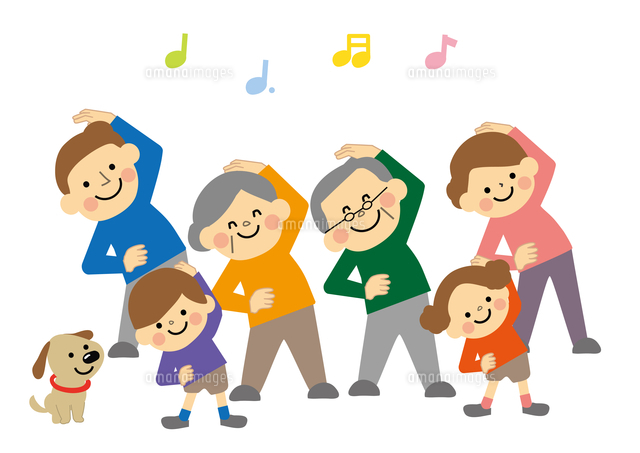
Now, readers, everyone on their feet.
It’s Radio Taiso time!
*****************************************************************************************
It’s Radio Taiso time!
*****************************************************************************************
IN ORDER TO EARN YOUR 10 POINTS FOR THIS CHALLENGE,
YOU MUST DO ANY TWO (2) OF THE VIDEOS BELOW FOR AT LEAST FIVE DAYS THIS WEEK!
(10 Total, 2 Each Day for 5 Days)
Sure, you may try them all at once, BUT, THIS IS A FIVE DAY ACTIVITY.
The Five Days Do Not Have To Be Consecutive.
In order to make sure you follow the “Japanese Tradition”, your 10 points will not be verified until Friday.
YOU MUST DO ANY TWO (2) OF THE VIDEOS BELOW FOR AT LEAST FIVE DAYS THIS WEEK!
(10 Total, 2 Each Day for 5 Days)
Sure, you may try them all at once, BUT, THIS IS A FIVE DAY ACTIVITY.
The Five Days Do Not Have To Be Consecutive.
In order to make sure you follow the “Japanese Tradition”, your 10 points will not be verified until Friday.
RADIO TAISO:
 https://youtu.be/XrEH5JLljDI
https://youtu.be/XrEH5JLljDIRadio Taiso with Modification (notice that it can be done sitting down!):
 https://www.youtube.com/watch?v=oQU-GDIjz6E&feature=em-share_video_user
https://www.youtube.com/watch?v=oQU-GDIjz6E&feature=em-share_video_userA Middle School During Their Physical Education Time:
 https://www.youtube.com/watch?v=3VPS9h8mGcU&feature=youtu.be
https://www.youtube.com/watch?v=3VPS9h8mGcU&feature=youtu.beAND MY FAVORITE: People Participating In All Walks Of Life
 https://www.youtube.com/watch?v=GEI5LxkPi-4
https://www.youtube.com/watch?v=GEI5LxkPi-4
And just in case these are too slow (or boring) for you, here is a more challenging version  :
:
And the little ones are just too hard to resist (watch the little girl in the front with the pigtails and the boy when the music picks up!):
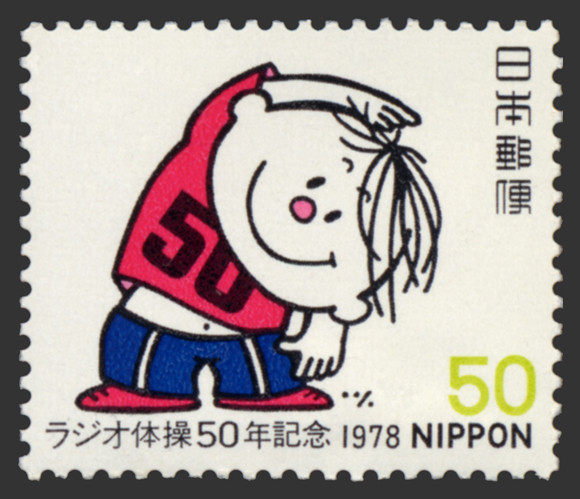
楽しむ
Tanoshimu!
(Have fun!)



Tanoshimu!
(Have fun!)
CHALLENGE #2: “Train Like A Sumo Wrestler!” (10 points)

We have arrived in Japan at the right time! They have finally “wrestled” (pun intended) the Emperor’s Cup away from Mongolia after a decade of dominance!

It’s a big one, isn’t it?
The average sumo wrestler weighs 326 pounds (148 kgs) and the newest champ weighs in at approximately 400 pounds.

To train like a Sumo Wrestler, we are going to do squats.
Sumo Squats.

First, let’s make sure we are all doing the basic squat correctly. Please watch the following video:
Now, for the basic Sumo Squat, the two videos below will give you the proper directions:




SUMO WRESTLING IS JAPAN’S NATIONAL SPORT!
We have arrived in Japan at the right time! They have finally “wrestled” (pun intended) the Emperor’s Cup away from Mongolia after a decade of dominance!

It’s a big one, isn’t it?
The average sumo wrestler weighs 326 pounds (148 kgs) and the newest champ weighs in at approximately 400 pounds.
Use this link to learn more about "A Day in the Life of a Sumo Wrestler"

To train like a Sumo Wrestler, we are going to do squats.
Sumo Squats.

First, let’s make sure we are all doing the basic squat correctly. Please watch the following video:
Now, for the basic Sumo Squat, the two videos below will give you the proper directions:
TO EARN YOUR 10 POINTS FOR CHALLENGE #2,
YOU NEED TO DO
140 SUMO SQUATS THIS WEEK.
TO MODIFY FOR YOUR PERSONAL ABILITY, YOU MAY DO “AIR” SQUATS
(NO WEIGHTS), OR USE A WEIGHT OF YOUR CHOOSING.
***PLEASE, NO MATTER WHAT YOUR PHYSICAL ABILITY***
***DO NOT TRY TO DO ALL 140 SUMO SQUATS***
***IN ONE DAY!!!***
YOU NEED TO DO
140 SUMO SQUATS THIS WEEK.
TO MODIFY FOR YOUR PERSONAL ABILITY, YOU MAY DO “AIR” SQUATS
(NO WEIGHTS), OR USE A WEIGHT OF YOUR CHOOSING.
***PLEASE, NO MATTER WHAT YOUR PHYSICAL ABILITY***
***DO NOT TRY TO DO ALL 140 SUMO SQUATS***
***IN ONE DAY!!!***



HAPPY SQUATTING!


Japan’s traditional festival, similar to Halloween, is called Obon (お盆), a custom to honor the spirits of one's ancestors. This Buddhist-Confucian tradition has evolved into a family reunion holiday, during which people return to ancestral family places to visit and clean their ancestors' graves. It is when the spirits of ancestors are supposed to revisit the household altars. It has been celebrated in Japan for more than 500 years and traditionally includes thousands of orange and red lanterns:
:origin()/pre04/4e71/th/pre/f/2012/251/3/7/bon_odori_by_elvengaard-d5dz8m3.jpg)
And a dance known as Bon-Odori:


Come on, don’t cry, you can do it!

Until next week:

幸せの旅
Shiawase no tabi!
Happy Travels!



CHALLENGE #3: “SAY NO TO KIT KATS!” (5 points)

Kit Kats are Japan’s favorite candy!
More than 300 flavors have be produced since 2000!
More than 300 flavors have be produced since 2000!
Japan’s traditional festival, similar to Halloween, is called Obon (お盆), a custom to honor the spirits of one's ancestors. This Buddhist-Confucian tradition has evolved into a family reunion holiday, during which people return to ancestral family places to visit and clean their ancestors' graves. It is when the spirits of ancestors are supposed to revisit the household altars. It has been celebrated in Japan for more than 500 years and traditionally includes thousands of orange and red lanterns:
:origin()/pre04/4e71/th/pre/f/2012/251/3/7/bon_odori_by_elvengaard-d5dz8m3.jpg)
And a dance known as Bon-Odori:

Japanese customs say it is impolite to knock on someone’s door on Halloween, or play a trick on anyone.
BUT,
OUR little goblins and ghosts will be bringing home candy, there will be leftovers, and the office folks will kindly “share”.
SO,
In order to torture you AND make you accountable throughout this week, with all these
GOODIES EVERYWHERE,
BUT,
OUR little goblins and ghosts will be bringing home candy, there will be leftovers, and the office folks will kindly “share”.
SO,
In order to torture you AND make you accountable throughout this week, with all these
GOODIES EVERYWHERE,

WE WILL BE STRONG!
WE WILL BE ACCOUNTABLE!
AND:
***IN ORDER TO EARN OUR 5 POINTS FOR CHALLENGE #3***
WE WILL STAY UNDER OUR CALORIE COUNT AT LEAST FIVE DAYS THIS WEEK!
(as posted in your MFP Diary)
This DOES NOT mean you can't eat candy!
It just means you have to control what you eat,
in order to stay under your calorie count!
WE WILL BE ACCOUNTABLE!
AND:
***IN ORDER TO EARN OUR 5 POINTS FOR CHALLENGE #3***
WE WILL STAY UNDER OUR CALORIE COUNT AT LEAST FIVE DAYS THIS WEEK!
(as posted in your MFP Diary)
This DOES NOT mean you can't eat candy!
It just means you have to control what you eat,
in order to stay under your calorie count!
Come on, don’t cry, you can do it!

WE HOPE YOU ENJOYED KYOTO AS MUCH AS A WASABI FLAVORED KITKAT!
Until next week:

幸せの旅
Shiawase no tabi!
Happy Travels!
12
This discussion has been closed.
 https://www.youtube.com/watch?v=u2htJ_gqxEA&feature=youtu.be
https://www.youtube.com/watch?v=u2htJ_gqxEA&feature=youtu.be https://www.youtube.com/watch?v=wCsHhiU99Gs&feature=youtu.be
https://www.youtube.com/watch?v=wCsHhiU99Gs&feature=youtu.be https://www.youtube.com/watch?v=Ep4JAf8hECE&feature=em-share_video_user
https://www.youtube.com/watch?v=Ep4JAf8hECE&feature=em-share_video_user https://www.youtube.com/watch?v=25GYAWDU4xw&feature=youtu.be
https://www.youtube.com/watch?v=25GYAWDU4xw&feature=youtu.be https://www.youtube.com/watch?v=aPYCiuiB4PA&feature=youtu.be
https://www.youtube.com/watch?v=aPYCiuiB4PA&feature=youtu.be https://www.youtube.com/watch?v=9ZuXKqRbT9k&feature=youtu.be
https://www.youtube.com/watch?v=9ZuXKqRbT9k&feature=youtu.be https://www.youtube.com/watch?v=Xq3WKwv8wF4&feature=youtu.be
https://www.youtube.com/watch?v=Xq3WKwv8wF4&feature=youtu.be